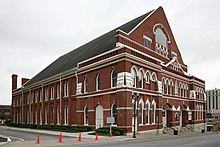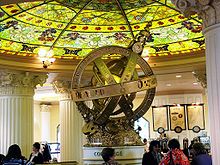Grand Ole Opry
|
|
|
|---|---|

|
|
| Radio show from Nashville | |
| publication | 1925 - today |
| production | WSM |
| Contributors | |
| Moderation | George D. Hay (1925–1944), Grant Turner (1944–1991) |
| Website | |
The Grand Ole Opry is the longest-running radio show in US broadcasting history. The country music concerts, broadcast weekly from Nashville since 1925, have enjoyed cult status for decades.
history
Beginnings

On October 5, 1925, the National Life & Accident Insurance Company owned radio station WSM began broadcasting. A month later, George D. Hay got on as program director, who was considered a promoter of old-time music . The Barn Dance Show , the forerunner of the Grand Ole Opry , was born on November 28th of the same year with 77-year-old Fiddler Uncle Jimmy Thompson as the first artist. From then on, the show aired every Saturday night and quickly became a huge hit. The first stars were Dr. Humphrey Bate and his Possum Hunters , DeFord Bailey or Uncle Dave Macon .
In 1927 the show was renamed the Grand Ole Opry . The range of the radio station was initially limited to rural Tennessee , but at the beginning of the 1930s WSM was assigned a new frequency range that enabled undisturbed reception throughout North America . In 1939, WSM was fed into the NBC network. The show became more and more important. For a country musician, the ultimate goal was to appear in the Grand Ole Opry.
In the early years, the broadcast was from the WSM studio, which was located in the insurance building of National Life Insurance. After a few intermediate stops, a new home was found in 1943 in the 3000-seat Ryman Auditorium , a former church, whose rustic interior provided an atmospheric ambience for the concerts.
Ascent
In the late 1930s, the Opry finally manifested its reputation and success. The concerts were constantly sold out and the radio station's quota was always satisfactory. Despite the competition from other shows, the Opry was always able to assert itself. She greatly encouraged the young talents who performed there. Roy Acuff , Hank Williams and Bill Monroe were just a few of the artists who became famous through their appearances on the show.
In the 1950s, the popularity among young listeners fell sharply. Rock 'n' Roll , which began around 1954, robbed country music of its youthful audience, and the Opry also suffered losses. Many artists from the "golden era" continued to make regular appearances. However, it was not possible to build on the earlier successes; the music scene had changed too much.
Move to Opryland
The Ryman Auditorium turned out to be too small despite its declining success. On March 16, 1974, the radio show moved from downtown Nashville to the “Opryland” entertainment complex located just outside the Cumberland River , whose concert hall can accommodate 4,400 spectators and is much more comfortable. The amusement park belonging to Opryland was closed in 1997 and converted into the “Opry Mills” shopping center and the largest hotel complex in the world, which is not connected to a casino , called “Gaylord Opryland Resort & Convention Center”.
The importance of the Grand Ole Opry has waned somewhat these days, but its cult status has remained, even if tourists now represent the majority of the audience. The shows are still broadcast on the American radio station WSM and the television station Great American Country Network.
Policy of the Opry
The management of the Grand Ole Opry was known for its conservative attitude. Drums and electric guitar were frowned upon for many years. They tried to keep all fashion trends out of the show. Rock 'n' roll, which had its origins in country music, was ignored. On October 2, 1954, a young singer named Elvis Presley appeared in the Grand Ole Opry; Legend has it that after this only appearance he was advised to return to work as a truck driver.
An artist could make guest appearances or become a permanent member. One problem for the permanent members was the harsh contractual conditions. A large number of appearances had to be promised for very little money (initially 26 shows on Saturday evening, later the number was reduced to 20, and you could take leave of absence for concerts abroad). If a permanent member announced himself to be a "Grand Ole Opry Star" during advertising campaigns for his tours, 15% of the income had to be transferred to the WSM. However, performers who were members of the Opry increased the sales of their records considerably. It was only in the 1970s that stars like Merle Haggard could afford not to appear there.
Cultural meaning
Because of its cultural and historical importance to the United States, the first national radio broadcast of the Grand Ole Opry, broadcast on October 14, 1939, via the NBC network, was included in the National Recording Registry of the Library of Congress on January 27, 2003 .
Europeans in the Opry

After one of the first Europeans to appear in the Grand Ole Opry with the entertainer Bobbejaan in 1953 , since then there have been guest appearances from outside the United States, such as the German Cripple Creek Band in 1996 , Linda Feller in 1998 or Tom Astor in 2000 , also both from Germany. In 2016, the Scorpions appeared in the Grand Ole Opry.
Former and current members
See Category: Member of the Grand Ole Opry
literature
- Jack Hurst: Grand Ole Opry . Abrams, New York 1975, ISBN 0-8109-0268-0
- Jack Hurst: Nashville's Grand Ole Opry. The first 50 years, 1925-1975 . Abrams, New York 1989, ISBN 0-8109-8094-0
Web links
- Website of the Grand Ole Opry
- Country Roads: In the footsteps of country music (GEO report; page 4, section "Nashville: Saturday Night Fever")
Individual evidence
- ^ Grand Ole Opry in the National Recording Registry. Retrieved August 12, 2017 .
- ↑ http://www.siebenbuerger.de/zeitung/artikel/alteartikel/2972-cripple-creek-band-begeistert-auch-pop_.html
- ^ "Linda Feller Biography" ( Memento from August 19, 2010 in the Internet Archive ).
- ↑ http://www.countrymusicnews.de/index.php?option=com_content&view=article&id=655:astor-tom-biografie&catid=28:kuenstlerportraits&Itemid=89
- ^ "Scorpions with Queensryche" ( Memento February 2, 2017 in the Internet Archive ).

